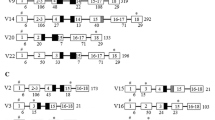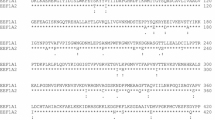Abstract
This work describes the cloning and structural analysis of a Tpt1 cDNA coding for the porcine translationally controlled tumor protein (TCTP) molecule and its expression in porcine cells and tissues. Pig Tpt1 cDNA is 842-pb long that displays typical features of translationally controlled mRNAs, including a 5′-UTR containing a 5′-terminal oligopyrimidine tract (5′-TOP), and a 3′-UTR with a high CG-content and one AU rich element (ARE). Both 5′-UTR and 3′-UTR are highly conserved when they are compared with those of other mammals. The pig Tpt1 cDNA contains a 516-b open reading frame that encodes a predicted TCTP protein composed of 172 amino acids that exhibits extensive conservation compared with TCTP sequences from other species and a common structural feature with all the other TCTP proteins analyzed in mammals. Expression analysis demonstrated that Tpt1 mRNA is ubiquitously expressed in normal porcine tissues and cells, showing a higher expression in spleen, lymph nodes and lung, and a lower one in skin and heart. The pig Tpt1 gene localizes on the porcine chromosome 11, region p11.






Similar content being viewed by others
Abbreviations
- ARE:
-
AU rich element
- DIG:
-
Digoxigenin
- DMSO:
-
Dimethylsulphoxide
- M-MLV:
-
Murine Moloney leukemia virus
- PBL:
-
Peripheral blood lymphocyte
- PBMC:
-
Peripheral blood mononuclear cell
- PBS:
-
Phosphate buffered saline
- SDS:
-
Sodium dodecylsulfate
- Tpt1 :
-
Translationally controlled tumor gene
- TCTP:
-
Translationally controlled tumor protein
References
Yenofsky R, Cereghini S, Krowczynska A, Brawerman G (1983) Regulation of mRNA utilization in mouse erythroleukemia cells induced to differentiate by exposure to dimethyl sulfoxide. Mol Cell Biol 3:1197–1203
Sánchez JC, Schaller D, Ravier F, Golaz O, Jaccoud S, Belet M, Wilkins MR, James R, Deshusses J, Hochstrasser D (1997) Translationally controlled tumor protein: a protein identified in several nontumoral cells including erythrocytes. Electrophoresis 1:150–155. doi:10.1002/elps.1150180127
Gachet Y, Tournier S, Lee M, Lazaris-Karatzas A, Poulton T, Bommer UA (1999) The growth-related, translationally controlled protein P23 has properties of a tubulin binding protein and associates transiently with microtubules during the cell cycle. J Cell Sci 112:1257–1271
Yarm FR (2002) Plk phosphorylation regulates the microtubule-stabilizing protein Tpt1. Mol Cell Biol 22:6209–6221. doi:10.1128/MCB.22.17.6209-6221.2002
Garrigos M, Deschamps S, Viel A, Lund S, Champeil P, Moller JV, le Maire M (1991) Detection of Ca(2+)-binding proteins by electrophoretic migration in the presence of Ca2+ combined with 45Ca2+ overlay of protein blots. Anal Biochem 194:82–88. doi:10.1016/0003-2697(91)90154-L
Xu A, Bellamy AR, Taylor JA (1999) Expression of translationally controlled tumour protein is regulated by calcium at both the transcriptional and post-transcriptional level. Biochem J 342:683–689. doi:10.1042/0264-6021:3420683
Kim M, Jung Y, Lee K, Kim C (2000) Identification of the calcium binding sites in translationally controlled tumor protein. Arch Pharm Res 23:633–636
MacDonald SM, Rafnar T, Langdon J, Lichtenstein LM (1995) Molecular identification of an IgE-dependent histamine-releasing factor. Science 269:688–690. doi:10.1126/science.7542803
Bhisutthibhan J, Pan XQ, Hossler PA, Walker DJ, Yowell CA, Carlton J, Dame JB, Meshnick SR (1998) The Plasmodium falciparum translationally controlled tumor protein homolog and its reaction with the antimalarial drug artemisinin. J Biol Chem 273:16192–16198. doi:10.1074/jbc.273.26.16192
Bhisutthibhan J, Meshnick SR (2001) Immunoprecipitation of [(3)H] dihydroartemisinin translationally controlled tumor protein (Tpt1) adducts from Plasmodium falciparum-infected erythrocytes by using anti-Tpt1 antibodies. Antimicrob Agents Chemother 45:2397–2399. doi:10.1128/AAC.45.8.2397-2399.2001
Baudet C, Perret E, Delpech B, Kaghad M, Brachet P, Wion D, Caput D (1998) Differentially expressed genes in C6.9 glioma cells during vitamin D-induced cell death program. Cell Death Differ 5:116–125. doi:10.1038/sj.cdd.4400327
Thomas G (1986) Translational control of mRNA expression during the early mitogenic response in Swiss mouse 3T3 cells: identification of specific proteins. J Cell Biol 103(6 Pt 1):2137–2144
Bohm H, Benndorf R, Gaestel M, Gross B, Nurnberg P, Kraft R, Otto A, Bielka H (1989) The growth-related protein P23 of the Ehrlich ascites tumor: translational control, cloning and primary structure. Biochem Int 19:277–286
Thiele H, Berger M, Skalweit A, Thiele BJ (2000) Expression of the gene and processed pseudogenes encoding the human and rabbit translationally controlled tumour protein (Tpt1). Eur J Biochem 267:5473–5481. doi:10.1046/j.1432-1327.2000.01609.x
Li F, Zhang D, Fujise K (2001) Characterization of fortilin, a novel antiapoptotic protein. J Biol Chem 276:47542–47549. doi:10.1074/jbc.M108954200
Zhang D, Li F, Weidner D, Mnjoyan ZH, Fujise K (2002) Physical and functional interaction between myeloid cell leukaemia 1 protein (MCL1) and fortilin. The potential role of MCL1 as a fortilin chaperone. J Biol Chem 277:37430–37438. doi:10.1074/jbc.M207413200
Tuynder M, Fiucci G, Prieur S, Lespagnol A, Géan A, Beaucourt S, Duflaut D, Besse S, Susini L, Cavarelli J, Moras D, Amson R, Telerman A (2004) Proc Natl Acad Sci USA 101(43):15364–15369. doi:10.1073/pnas.0406776101
MacDonald SM, Paznekas WA, Jabs EW (1999) Chromosomal localization of tumor protein, translationally controlled 1 (Tpt1) encoding the human histamine-releasing factor (HRF) to 13q12>14. Cytogenet Cell Genet 84:128–129. doi:10.1159/000015238
Fiucci G, Lespagnol A, Stumptner-Curvelette P, Beaucourt S, Duflaut D, Susini L, Amson R, Telerman A (2003) Genomic organization and expression of mouse Tpt1 gene. Genomics 81(6):570–578. doi:10.1016/S0888-7543(03)00047-8
Lunney JK (2007) Advances in swine biomedical model genomics. Int J Biol Sci 3(3):179–184
Jiménez-Marín AM, Moreno A, Martín de las Mulas J, Millán Y, Morera L, Barbancho M, Garrido J (2005) Localization of CD9 transcript and protein in pig cell and tissues by PCR and immnunohistochemistry. Vet Immunol Immunopathol 104:281–288. doi:10.1016/j.vetimm.2004.12.009
Mingone F, Grillo G, Licciulli F, Iacono M, Liuni S, Kersey PJ, Duarte J, Saccone C, Pesole G (2005) UTRdb and UTRsite: a collection of sequences and regulatory motifs of the unstranslated regions of eukaryotic mRNNs. Nucleic Acid Res 33:D141–D146 Database issue
Higgins DG, Thompson JD, Gibson TJ (1996) Using CLUSTAL for multiple sequence alignments. Methods Enzymol 266:383–402. doi:10.1016/S0076-6879(96)66024-8
Yerle M, Pinton , Robic A, Alfonso A, Palvadeau Y, Delcros C, Hawken R, Alexander L, Beatti C, Schook L, Milan D, Gellin J (1998) Construction of a whole-genome radiation hybrid for high resolution gene mapping in pigs. Cytogenet Cell Genet 82:182–188. doi:10.1159/000015095
Milan D, Hawken R, Cabau C, Leroux S, Genet C, Lahhib Y, Tosser G, Robic A, Hatey F, Alexander L et al (2000) IMpRh server: an RH mapping server available on the Web. Bioinformatics 16:558–559. http://www.imprh.toulouse.inra.fr
Barreau C, Paillard L, Osborne HB (2005) AU-rich elements and associated factors: are there unifying principles? Nucleic Acids Res 17:8367
Gross B, Gaestel M, Bömh H, Bielka H (1989) cDNA sequence coding for a translationally controlled human tumor protein. Nucleic Acids Res 17:8367. doi:10.1093/nar/17.20.8367
Bommer UA, Thiele BJ (2004) The translationally controlled tumour protein (Tpt1). Int J Biochem Cell Biol 36:379–385. doi:10.1016/S1357-2725(03)00213-9
Chung S, Kim M, Choi W, Chung J, Lee K (2000) Expression of translationally controlled tumor protein mRNA in human colon cancer. Cancer Lett 156:185–190. doi:10.1016/S0304-3835(00)00460-2
Bommer UA, Borovjagin AV, Greagg MA, Jeffrey IW, Russell P, Laing KG, Lee M, Clemens MJ (2002) The mRNA of the translationally controlled tumor protein P23/Tpt1 is a highly structured RNA, which activates the dsRNA-dependent protein kinase PKR. RNA 8:478–496. doi:10.1017/S1355838202022586
Andree H, Thiele H, Fähling M, Schmidt I, Thiele BJ (2006) Expression of the human Tpt1 gene coding for translationally controlled tumor protein (Tpt1) is regulated by CREB transcription factors. Gene 380:95–103. doi:10.1016/j.gene.2006.05.018
Schmidt I, Fähling M, Nafz B, Skalweit A, Bernd-Koachim T (2007) Induction of translationally controlled tumor protein (TCTP) by transcriptional and post-transcriptional mechamisms. FEBS J 274:5416–5424. doi:10.1111/j.1742-4658.2007.06069.x
Shinha P, Kohl S, Hütter G, Kern M, Köttgen E, Dietel M, Lage H, Schnölzer M, Schadendorf D (2000) Identification f novel proteins associated with the development of chemoresistance in malignant melanoma using two-dimensional electrophoresis. Electrophoresis 21:3048–3057. doi :10.1002/1522-2683(20000801)21:14<3048::AID-ELPS3048>3.0.CO;2-W
Decker CJ, Parker R (1995) Diversity of cytoplasmic functions for the 3′ untranslated region of eukaryotic transcripts. Curr Opin Cell Biol 7(3):386–392. doi:10.1016/0955-0674(95)80094-8
Peng SS, Chen CY, Xu N, Shyu AB (1998) RNA stabilization by the AU-rich element binding protein, HuR, an ELAV protein. EMBO J 17(12):3461–3470. doi:10.1093/emboj/17.12.3461
Tuynder M, Susini L, Prieur S, Besse S, Fiucci G, Amson R, Telerman A (2003) Translationally controlled tumor protein is a target of tumor reversion. Proc Natl Acad Sci USA 99:14976–14981. doi:10.1073/pnas.222470799
Strehl S, Glatt K, Liu QM, Glatt H, Lalande M (1998) Characterization of two novel protocadherins (PCDH8 and PCDH9) localized on human chromosome 13 and mouse chromosome 14. Genomics 53(1):81–89. doi:10.1006/geno.1998.5467
Acknowledgments
We are grateful to M. Yerle and D. Milan for providing the panel of irradiated pig/hamster somatic hybrid cells. The authors thanks to Reyes Álvarez (Universidad de Córdoba, Spain) and Jordi Estellé (Universidad Autónoma de Barcelona, Spain) for excellent technical assistance. This work has been founded by the National R&D Program Grant of the Spanish Ministry of Education and Science (AGL2002-00529and AGL2005-01561). AJM is a postdoctoral research fellow supported by an EADGENE fellowships. NY and GE are predoctoral research fellows of the University of Córdoba, Spain. JJG was a recipient of a “Ramón y Cajal” grant of the Spanish Ministry of Education and Science.
Author information
Authors and Affiliations
Corresponding author
Rights and permissions
About this article
Cite this article
Yubero, N., Esteso, G., Cardona, H. et al. Molecular cloning, expression analysis and chromosome localization of the Tpt1 gene coding for the pig translationally controlled tumor protein (TCTP). Mol Biol Rep 36, 1957–1965 (2009). https://doi.org/10.1007/s11033-008-9405-2
Received:
Accepted:
Published:
Issue Date:
DOI: https://doi.org/10.1007/s11033-008-9405-2




